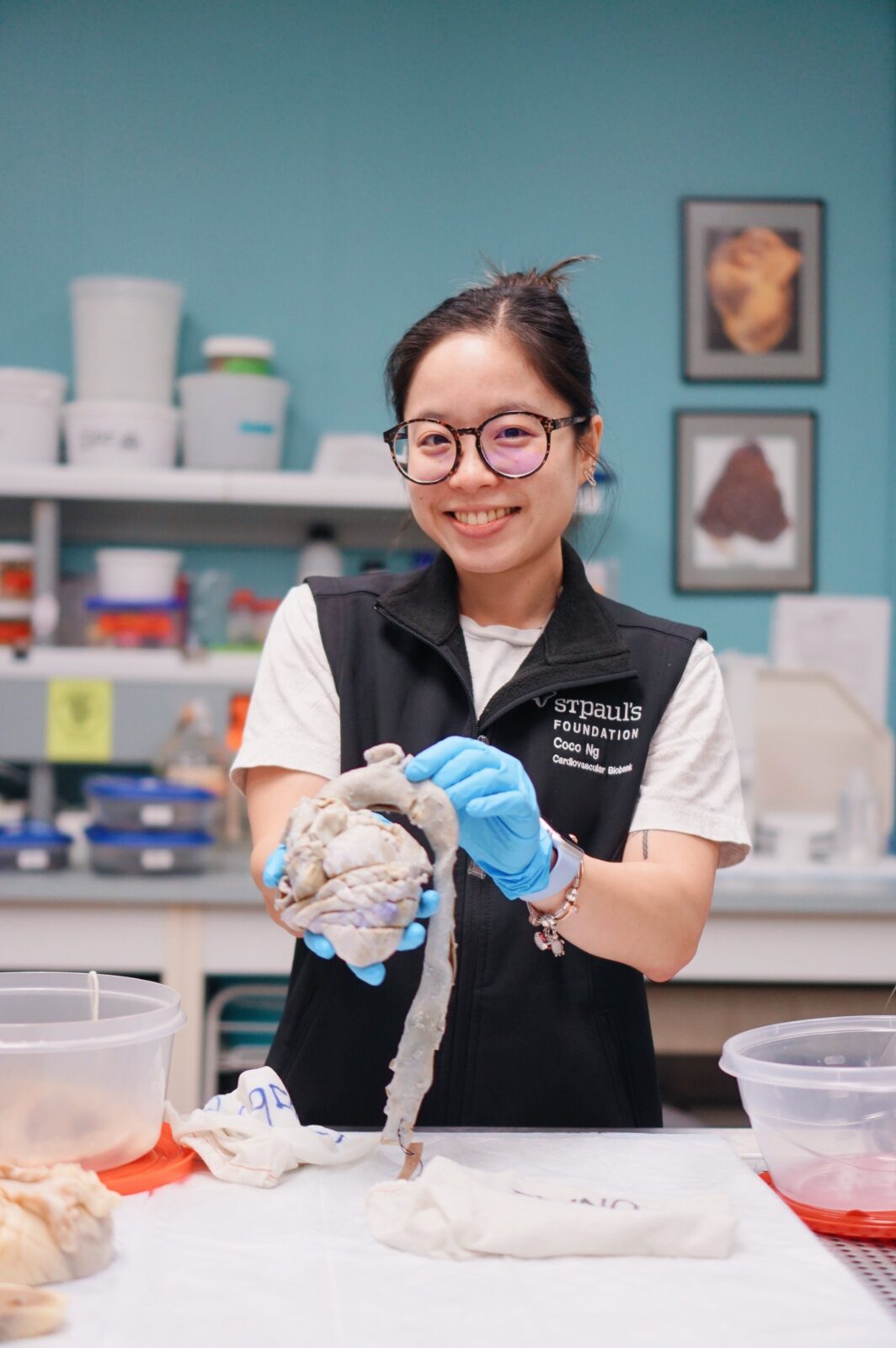The Day of the Reunion
2:30 PM – THE REUNION
“Wow… I never in my life expected that I would hold my own heart”, murmurs Asher softly. “This big thing carried me for 55 long years, eh”.
In the Bruce McManus Cardiovascular (Heart) Biobank (BMCB), I stand across from Asher and watch them admire one of their very own organs.
“Quite surreal, isn’t it?”
Let me tell you how we got here – this deep, rich, heart-felt (pun intended) moment. From the combined efforts of the many healthcare departments at St. Paul’s Hospital and the heart biobank team, what follows is a story about a significant day at the biobank – the first time I ever witnessed someone holding their own heart.
Have you ever wondered what happens to a heart removed (“explanted”) during a transplant surgery? You may think that because the heart is diseased, it would be of no use, discarded. But the journey of an explanted heart does not end upon removal. Each diseased heart still holds tremendous value for researchers. Heart researchers at the UBC Centre for Heart Lung Innovation, located in the heart of St. Paul’s Hospital, are dedicated to studying and understanding cardiovascular diseases. This includes giving explanted hearts a second home in our research laboratory, the BMCB. At the heart biobank, we are the final custodians of explanted hearts, preserving these patient-consented organs for research.
The BMCB is Western Canada’s largest and most comprehensive repository of human heart and cardiovascular tissue. Since 1982, the BMCB has collected over 100,000 specimens, including 550+ explanted hearts and other surgically removed tissues. These tissues are retrieved, anonymized, and meticulously processed, all within 24 hours! We use various preservation methods, such as flash-freezing and storing in long-term preservation chemicals, for a wide range of research studies. In a nutshell, this workflow is “biobanking” – collecting, processing, storing, and managing biological samples to advance scientific discovery.
The heart biobank provides researchers from around the world with high-quality tissue and clinically annotated patient data to accelerate discoveries in heart disease. As a biobank technician, I am responsible for all the heart tissue collected at the biobank. My role is critical in bridging the gaps between patients, clinicians, and researchers. I also help these groups understand how heart diseases develop and progress, connecting and mobilizing knowledge from bench to bedside.
2 Months Earlier – The Transplant
9:00PM – THE CALL
The alarm of my heart pager rings. This means that a heart transplant has been scheduled for the following day. It is typical for the heart biobank team to be paged at odd times of the day. Whenever heart transplants occur, multiple units, including the heart biobank team, BC Transplant Society, Cardiac Surgery Department, and Pre- and Post-Transplant Clinic, are involved to ensure the process is smooth and efficient.
St. Paul’s Hospital is British Columbia’s only site for adult heart transplants (BC Children’s Hospital performs pediatric heart transplants); therefore, all explanted hearts (from transplant) now reside with us, at the heart biobank. These hearts serve an important secondary purpose in supporting research, training, and education.
10:00AM – THE PREPARATION
Preparing for the retrieval of today’s explanted heart goes well. We get our tools and equipment ready and coordinate with the operating room team to ensure that the transplant is on schedule.
I go to meet today’s transplant recipient, Asher, to obtain informed consent for use of their explanted heart for research. They are hesitant and unsure about giving consent. I mention that regardless of their decision, they also have the opportunity to visit their explanted heart after surgery. All explanted hearts are kept at the biobank upon removal – even those that are not consented for research use.
Once these preparations are done, it is time for the waiting game.
1:00PM – THE BIOBANKING
The heart pager rings. The heart is out. I make my way to the operating room with purpose.
The heart biobank team has to act quickly to preserve the heart tissue before it starts to degrade. Once the explanted heart reaches the biobank, we swiftly begin our biobanking protocol. We first image, weigh, and note down any unusual observations. Then we begin sectioning out small pieces of the heart, including the greater arteries, valves, appendages, coronaries, and muscle. We preserve each of these sections of the heart by four different methods! These biobanking formats enable researchers to engage in a variety of research applications. Some are interested in examining genetic composition, microanatomy, and biomarkers that could lead to the development of therapeutics. Others are interested in how doctors can treat and prevent heart disease better with new tools and drugs. Even though we section out small pieces of the heart, after biobanking, the majority of the organ remains intact.
We follow a standard protocol when biobanking an explanted heart to ensure consistency and quality across each sample. It goes without saying that this standardization is important. What is truly remarkable is that each piece of the heart has the potential to lead to a discovery.
But every so often, the impact of these hearts extends far beyond the lab bench. Part 2, coming next week, follows one such moment: a reunion between a person and their own heart.

Coco Ng stands holding a fixed, human heart in the BMCB laboratory space. Photo by Tiffany Chang.
